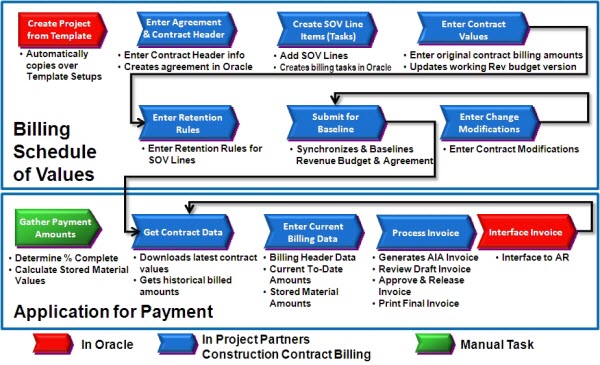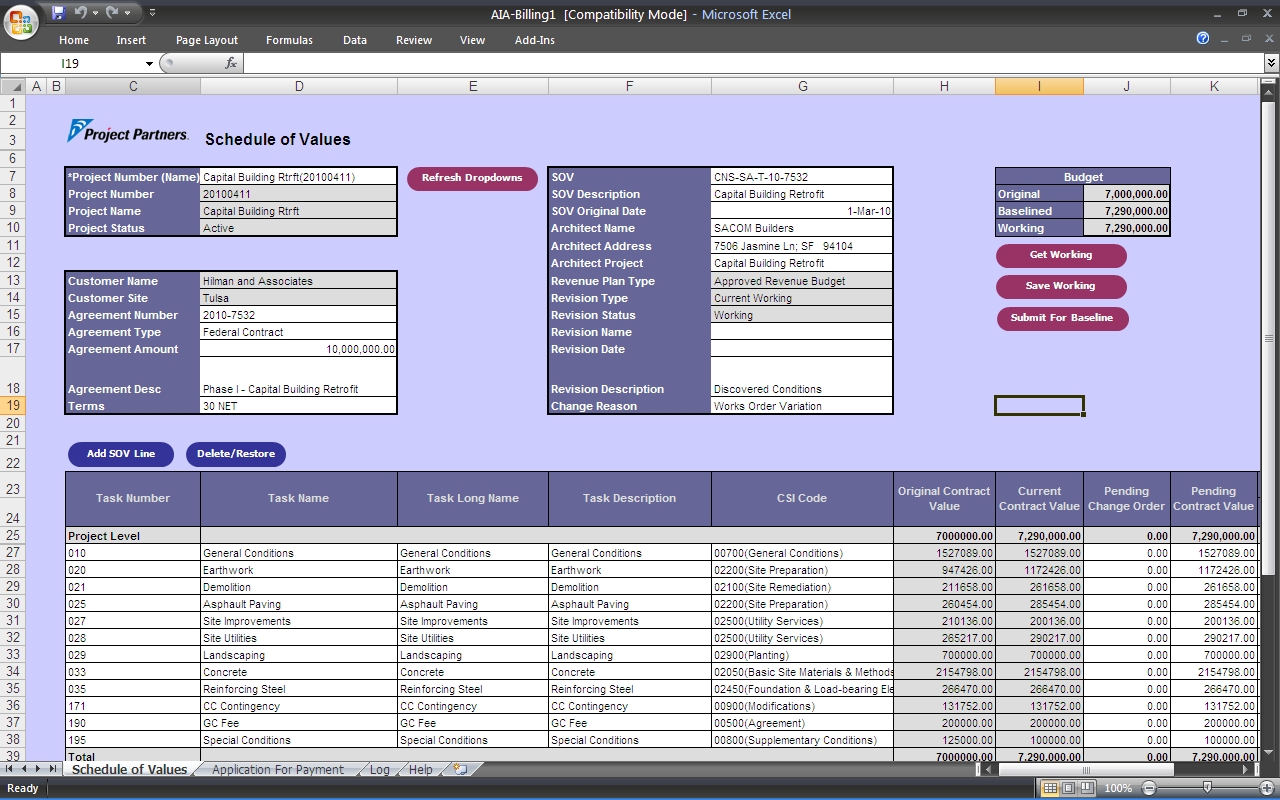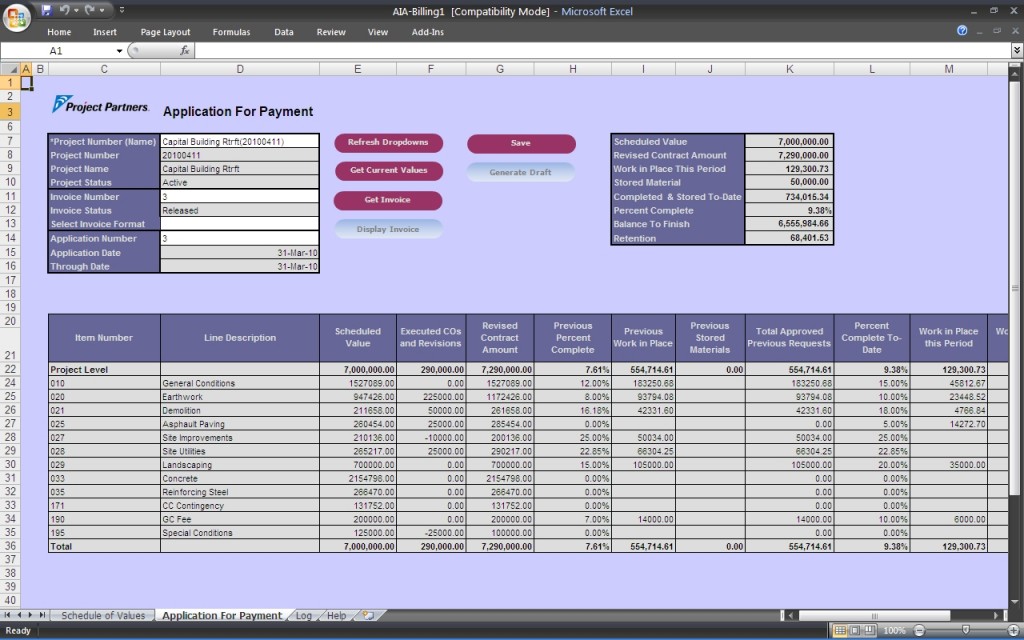By John May
In 1992, the American Institute of Architects® formalized a standardized “percentage of completion” contract billing methodology. The forms developed are known by their numerical assignments: G702 and G703. The purpose was to allow contractors, owners, architects, and construction managers a familiar way of communicating and authorizing payments during the life of a construction contract.
Users of Oracle E-Business Suite Projects applications have always had a sophisticated billing system but generally required an off-system solution for invoice presentation. As a result, users have created custom reports, offline invoicing tools, and other custom solutions.
While there are non-integrated invoicing solutions for AIA-compliant billing on the market, Project Partners has developed a fully integrated solution using Microsoft Excel-based worksheets to control completely, process, and print invoices in these standard formats.
The solution, however, goes way beyond mere invoice printing to reduce invoicing labor by 65%. Using the easy Microsoft® Excel interface of Project Partners Construction Contract Billing™, Project Managers and financial administrators can perform the following functions within Oracle Projects:
- Maintain contract billing information
- Enter and maintain change orders
- Maintain Billing Tasks
- Update and baseline revenue budgets
- Manage Billing Retention Rules
- Generate Draft Invoices
- Review and Print AIA formatted Application for Payment invoices
Business Process Flow for Project Partners Construction Contract Billing
The following business process flow shows how Project Partners Construction Contract Billing is used to manage your project contract tracking and billing flow.
The Billing Schedule of Values and Application for Payment worksheets, delivered with Project Partners Construction Contract Billing (Construction Contract Billing), are configured to integrate Oracle E-Business Suite Project Billing data to manage revenue budgets, billing tasks, retention rules, and processing project invoices in Oracle.
Billing Schedule of Values Worksheet
The Billing Schedule of Values worksheet manages your contract budgeting data. All relevant data is shown on one convenient worksheet, eliminating the need to navigate various forms to enter and maintain your data.
Agreement and Contract Header Data
All the contract header information is entered into the worksheet. First, the user enters the required agreement header data to create and update Oracle Project Billing’s agreement. Next, the actual contract header information used to develop the AIA-compliant invoice format is entered, including the name, description, and original contract approval date. Also, the client’s architect information is included and maintained in this worksheet.
The revenue budget version header is finally entered to create the project’s revenue budget amounts. This data is used to create both the original budget version and subsequent budget versions and relate those versions to the contract change orders.
Schedule of Value Line Items
Schedule of Values [SOV] contract line items are created and maintained in the SOV Line item section. The worksheet automatically creates and integrates these line items as billing tasks into Oracle Projects. In addition, a convenient CSI coding field is included for optional use to categorize SOV line items.
Contract Values
Original contract values are entered on each line item and uploaded into the current working budget version. As revisions are authorized, a new version is entered into the worksheet and baselined into the Approved Revenue Budget.
Retention Rules
With the same Billing SOV worksheet, standard Oracle Project Billing Retention Rules are entered and maintained in the Retention Rules columns of the SOV Line items section. In addition, separate rules for Completed Work and Stored Materials are available for users as needed. These rules are used to estimate the withheld retention amounts within the Application for Payment worksheet and by Oracle Project Billing to calculate the retention amounts for invoice generation.
Baselining Budget
Once the original contract amounts have been entered and saved to Oracle Projects, the user can submit the new budget version for baselining. Construction Contract Billing can automatically submit and baseline the current working version in Oracle. Optionally, if the user implements the budget approval workflow, then the Submit for Baseline action will trigger the workflow and follow standard Oracle workflow processes and procedures.
Contract Revisions
Maintaining correct change order information is vital for accurate processing and reporting in the G702/3 billing forms. Therefore, users can track change orders by entering the change order header and amounts after processing the original baseline budget. Change order information is stored in conjunction with the standard budget version data.
Users do not have to use Oracle Project Management’s Control functionality. For example, tracking and maintaining change orders is independent of the standard change order process.
Application for Payment
Project Partners Construction Contract Billing generates invoices using the Application for Payment worksheet. This worksheet integrates the latest baselined contract amounts and current billing data and allows the user to create an invoice directly from the worksheet in Oracle Projects.
Application for Payment Billing Header Data
Users start creating an Application for Payment (AFP) invoice by entering the billing header data to ensure the correct invoice information is made. This includes the AFP sequence number, bill through date, and, optionally, the AR invoice number.
Get Contract Data
Once the header information is entered, the user retrieves the current contract and historical billing amounts from Oracle Projects. This is performed by clicking on a button within the worksheet. To ensure that you have the most current values in your spreadsheet, you refresh your data using the “Get Current Values” button. This will re-populate all the fields with the most recent data. Next, contract data is coordinated by entering the correct bill through a date to ensure the contract version is used to generate billing amounts.
Enter Current Period Percent Complete or To-Date Billing Amounts
Users can enter the current period billing amounts by entering a percent complete value on the SOV line item or manually enter the To Date Completed Work amount for each item. The worksheet automatically calculates the summary and current billing values, and amounts are entered. Additionally, the user can save their data anytime in the Oracle database.
Enter Stored Material Amounts
Many contracts have provisions for the contractor to bill for Materials bought and stored either on-site or in a secure location but have not been used in the completed work calculations. Different amounts can be entered to bill for unconsumed materials.
Generate Draft Invoice
To generate an invoice, all the user has to do is click a button within the worksheet. The standard Generate Draft invoice process is used in conjunction with Project Partner’s Invoice application to generate and optionally print the G702/3 invoice.
Users can optionally approve and release invoices within the AFP worksheet, assuming the correct responsibility functions. Otherwise, standard approval and release functions can be performed within Oracle Project Billing.
Review Historical Invoices
With the AFP worksheet, users are also able to review historical invoices which have been previously released. Both the worksheet calculation amounts are displayed, and the ability to review the Pro-forma invoice.
Project Partners Construction Contract Billing fully integrates Oracle Project Billing and Oracle Receivables and leverages the technology of Project Partners Invoicing to create a complete invoicing solution for the Engineering & Construction Industry.
For more information about Project Partners Construction Contract Billing and to see the online demonstration and webinar: http://www.projectp.com/products/cc_billing.php.
All trademarks are the property of their respective owners.



